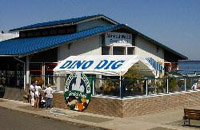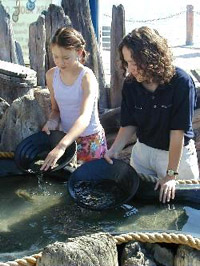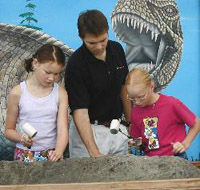 |
|||
|
|||
|
Copyright
Between a rock and a
BY RICK HUDSON
Background:In 1991 my wife quit her job as controller of Coca Cola (Victoria) and started a small tourist attraction called the Scratch Patch. Popular with adults and children alike, the 'Patch' was a 300 square metre outside garden filled with about a ton of polished semi-precious gemstones. There was also a pool filled with small tropical shells. The result was a rewarding beachcombing experience (which happened to be on the waterfront). For a few dollars, a visitor could buy an empty bag and fill it with whatever they liked ... agates, cowrie shells, amethyst, jasper, mother-of-pearl, and more.
The following winter, to fill in the off-season, she began inviting schools to attend hands-on rock and mineral classes. Thus was born the 'Doc Rock' lessons, which involved a talk on rocks and minerals (with lots of interesting specimens passed around), a field trip to the Scratch Patch to find specific gems (which were then glued to a collector's card), and then some free time to hunt for whatever they liked. The classes became very popular as the years passed, and more and more teachers realized what a great resource the lessons were to their curriculum.
Expanding the project:At the back of our minds, we were always looking to expand the program to include a wider field of earth science related projects. In 1998, while attending a museum conference, we saw a synthetic fossil dig designed for children. While we liked the concept, we were unhappy with the details. The children used a trowel to excavate, and the 'rock' produced a lot of dust, which would be a problem, even in an outside attraction.
The question of fossils was easily solved. There are huge numbers of common fossils available at trade shows, sold by the pound or kilo. We had long ago decided (a) that the kids should be able to keep what they found, and (b) that the fossils should be intellectually interesting. What remained to be done was to determine how many fossils to how much rock. Or, to put it another way, how do you try to have every small child find something, when teenagers can rip through the rock at five times the rate? A series of experiments (adding/subtracting bonding agents), plus factoring in the variable temperatures during the day (early mornings were cold, and rock much harder than at midday), meant a series of compromises. In 1999 we opened the DinoDig. To limit participants (8 at a time), we charged a minimal amount ($2.50) so that people appreciated they were getting something of value. (If it's free, people seldom respect it.) To publicize the facility, we started in April, with a covering tent (it rains here on the West Coast!) and invited school classes to participate. One of our first visitors was a local TV show that gave the DinoDig airtime. So, before the summer had really begun, the news had spread through the local schools that there was something 'new and cool' to do at Mineral World. We hired two university students to manage the summer operation. One or both were on-site each day. They were given training in paleontology, modern excavation skills, and crowd management. Information boards, sample specimens and ID cards were also provided. In this way, participants learned as well as experienced, and parents could take away the printed matter, and relate it to the child's discoveries at a later date. We learned a number of interesting things over that summer:
Other sites:
It has also been somewhat surprising that we seem to be a pioneer in this field. Over the past two years, numerous museums (both national and international) have contacted us, and asked for details. It has always been freely given. We are a commercial operation, but provided we can assist with just a few emails, we believe this aid to learning is too important to be franchised or sold. It's there for the asking.
Copyright © 2001 Rick Hudson This article may not be copied, distributed or reprinted in any form without the author's permission. To contact the author, please use the e-mail address provided. If you are unable to contact the author, please contact the Canadian Rockhound. Authorized reprints must acknowledge the author, and the Canadian Rockhound, and include the website URL address of the Canadian Rockhound.
|
||||||||
 
Copyright © 2001 Canadian Rockhound
Back Issues |
News & Events |
Junior Rockhound
|
||||||||





